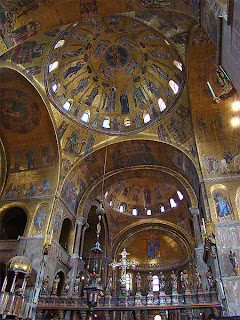White Tower the oldest portion of the compound.
The Tower is actually a compound of structures built through the ages for varying purposes, mostly as expressions of royal power. The oldest is the White Tower, begun by William the Conqueror in 1078 to keep London's native Saxon population in check. Later rulers added other towers, walls, and fortified gates, until the buildings became like a small town within a city. Until the reign of James I (beginning in 1603), the Tower was also a royal residence. But above all, it was a prison for important captives.
The Tower, besides being a royal palace, a fortress, and a prison, was also an armory, a treasury, a menagerie, and, in 1675, an astronomical observatory.
2. Ponte Vecchio: Florence, Italy
The oldest and most famous bridge across the Arno, the Ponte Vecchio we know today was built in 1345 by Taddeo Gaddi to replace an earlier version. The characteristic overhanging shops have lined the bridge since at least the 12th century.
3. Alcazr: Segovia, Spain
The Alcázar of Segovia (literally, Segovia Castle) is a stone fortification, located in the old city of Segovia, Spain. Rising out on a rocky crag above the confluence of the rivers Eresma and Clamores near the Guadarrama mountains, it is one of the most distinctive castle-palaces in Spain by virtue of its shape - like the bow of a ship. The Alcázar of Segovia, like many fortifications in Spain, started off as an Arab fort, but little of that structure remains. It has served as a royal palace, a state prison, a Royal Artillery College and a military academy since then.
4. The Doge's Palace; Venice, Italy
Doge is the Italian word for Duke. The Doge was elected to govern Venice.
5. Book of Kells
Before mechanical printing every stage in the creation of a medieval book required intensive labor, sometimes involving the collaboration of entire workshops. Parchment for the pages had to be made from the dried hides of animals, cut to size and sewn into quires; inks had to be mixed, pens prepared, and the pages ruled for lettering. A scribe copied the text from an established edition, and artists might then embellish it with illustrations, decorated initials, and ornament in the margins. The most lavish medieval books were bound in covers set with enamels, jewels, and ivory carvings.
The Book of Kells is one of the most famous of these books. The book illustrates the four Gospels using Christian iconography and insular art (island - British Isle art). The book is written in Latin.
6. Bayeux Tapestry
Is a long embroidered cloth that depicts the events that led to the Norman conquest of England and the Battle of Hastings. It is annotated in Latin.
7. Notre Dame: Paris, France
Is considered the finest example of French Gothic Architecture. This type of architecture is characterized by pointed arches, rib vaulting, lightness (vast expansive stained glass windows), soaring spaces (height made possible by flying buttresses), and decorative sculptures.
8. San Marco (St. Mark's Basilica): Venice, Italy
Is considered one of the finest examples of Byzantine Architecture. It is reputed to have the relic of Mark the evangel. The building was originally part of the Doge's Palace.
9. Alhambra: Granada, Spain
This fortress is considered one the finest examples of Muslim Architecture.
10. Tower of Pisa: Pisa, Italy
Leaning Tower of Pisa is a freestanding bell tower of the cathedral at Pisa. The tower now leans at almost a 4 degree angle. Due to a poor foundation the structure started to sink and would have toppled over had construction not halted for years after the third floor was added. This structure is an example of Romanesque Art, which combines Roman and Byzantine characteristics (small windows, thick stone walls, large towers, round arches and decorative details inside.
11. Westminster Abbey: London, United Kingdom
Westminster is a gothic church and the traditional location of coronation and burial of English and later British royals. It is also known as Poet's Corner because Chaucer was buried there because he was master of the Kings Works. Other famous authors have been buried or memorialized alongside Chaucer.
12. St. Basil Cathedral: Moscow, Russia
St. Basil Cathedral is located in Moscow, Russia. This cathedral was built during the reign of Ivan IV in the Red Square to commemorate the capture of Kazan and Astrakhan. It is the most famous site at Red Square.
13. Hohe Domkirche St. Peter und Maria (Cologne Cathedral): Cologne, Germany
It is one of the largest churches in the world and one of the most recognizable structures in Germany. It is the seat of the Archbishop of Cologne. It is an example of neo Gothic Architecture.
14. Basilica di Santa Maria del Flore; Florence, Italy
14. Basilica di Santa Maria del Flore; Florence, Italy
Referred to as Il Duomo the structure's dome was one of the largest in the world until recent years. It remains the largest brick dome ever built. The cathedral is known for its Renaissance dome designed by Brunelleschi. This is the seat of the Archbishop of Florence.
Torii at Itsukushima
Torii at Hiroshima
Torii at Ise - The site of the Ise Shrine has long been sacred, due to its forests of sacred Japanese cypress trees.
15. Shinto Shrine (Torii) : Japan
Shinto shrines (Japanese: jingu) are the dwelling places of the kami. The most well-known architectural aspect of the Shinto shrine is the torii, a symbolic gate that marks the entrance to the sacred area surrounding the shrine. The most sacred shrines in Shinto are those at Ise Jingu. There are thousands of Shinto shrines in Japan.









































